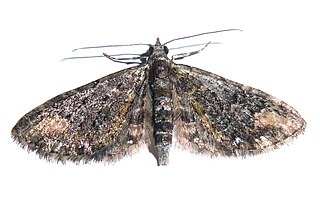
Eupithecia venosata, the netted pug, is a moth of the family Geometridae. It was first described by Johan Christian Fabricius in 1787. It is found across the Palearctic realm from Portugal and Morocco in the west to the Lake Baikal in Siberia and Afghanistan and Pakistan in the east.

Eupithecia satyrata, the satyr pug, is a species of moth of the family Geometridae. It was described by Jacob Hübner in 1813. It is found from Ireland, through northern and central Europe east to all of Russia and central Asia and western Siberia to Tibet. It is also present in North Africa and North America.
Scopula karischi is a moth of the family Geometridae. It was described by Claude Herbulot in 1999. It is found on Bioko, an island of the west coast of Africa that is part of Equatorial Guinea.

Eupithecia distinctaria, the thyme pug, is a moth of the family Geometridae. It is found throughout Europe. It is also found in Iran. from the Iberian Peninsula through western and central Europe including the British Isles as well as further east as far east as far as Russia and Iran. In the north the range reaches as far as the southern Fennoscandia, to the south, where it is more common, it occupies the Mediterranean and Asia Minor. It is found primarily on warm, stony slopes and rocky structures as well as on sparse grassy areas with thyme mounds. In the Alps, it rises to heights of 2000 metres.
Eupithecia mundiscripta is a moth in the family Geometridae. It is found in New Guinea, Taiwan, India (Meghalaya), the Philippines, Thailand, Vietnam, Malaysia, Sumatra, Borneo and Seram.
Eupithecia dohertyi is a moth in the family Geometridae described by Louis Beethoven Prout in 1935. It is found in Cameroon, Equatorial Guinea, Kenya, Rwanda, and Uganda.
Eupithecia fernandi is a moth in the family Geometridae. It is found in Equatorial Guinea (Bioko).

Eupithecia gradatilinea is a moth in the family Geometridae. It is found in Equatorial Guinea (Bioko), Kenya, Malawi, South Africa, Zambia and Zimbabwe.
Eupithecia jeanneli is a moth in the family Geometridae. It is found in Equatorial Guinea, Kenya and Uganda.
Eupithecia karischi is a moth in the family Geometridae. It is found in Equatorial Guinea (Bioko).
Eupithecia nigribasis is a moth in the family Geometridae. It is found in Cameroon, the Democratic Republic of Congo, Equatorial Guinea, Kenya and South Africa.
Eupithecia oculata is a moth in the family Geometridae. It was described by David Stephen Fletcher in 1956. It is found in Cameroon and Equatorial Guinea.
Eupithecia sodalis is a moth in the family Geometridae. It is found in Equatorial Guinea (Bioko).
Mesoptila deviridata is a moth in the family Geometridae. It is found in New Guinea.
Mesoptila unitaeniata is a moth in the family Geometridae first described by William Warren in 1906. It is found in New Guinea.
Eupithecia leucoprora is a moth in the family Geometridae. It is found in New Guinea.
Eupithecia lissopis is a moth in the family Geometridae. It is found in New Guinea.
Eupithecia placens is a moth in the family Geometridae. It is found in New Guinea.
Eupithecia tenuiscripta is a moth in the family Geometridae. It is found in New Guinea.
Eupithecia fuliginata is a moth in the family Geometridae. It was described by David Stephen Fletcher in 1958. It is found in the Rwenzori Mountains of eastern equatorial Africa.



